114+ Copywriting Formulas to Get Traffic & Leads
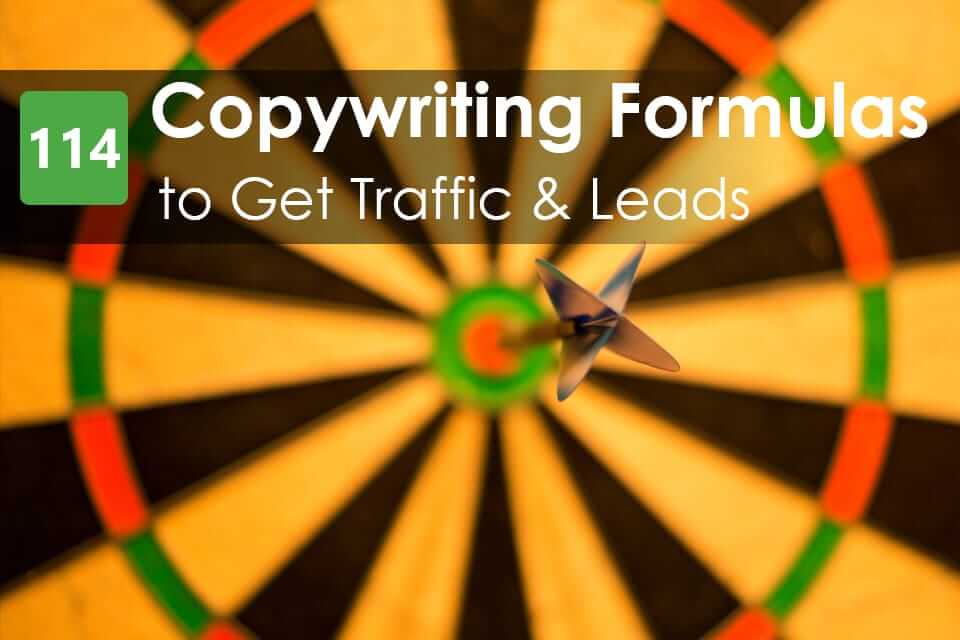
Copywriting formulas are an easy and effective way to write great copy without having to start from scratch every time. That’s why copywriters have been using them for years. Why wouldn’t you use proven formulas – used by master copywriters – that you can find in all areas of copywriting, and that save time by telling you exactly what to do and where to do it?
To make it even easier for you, we’ve created a comprehensive collection of the best copywriting formulas, with simple examples, all in one place – a quick and easy reference for you to use.
Introducing An Exhaustive Guide to Copywriting Formulas
Start from the start, or just pick the chapters that are most relevant to you.
Keep in mind that even though the formulas have been divided into different chapters to make it easier for you to find what you need, you can apply most of them to more than just one area of copywriting.

Chapter 1: Formulas for Headlines
Writing compelling headlines that grab your reader’s attention and convince them to keep reading is incredibly important, but sometimes you might not have the time to spend hours on perfecting your headline. These formulas are a quick and effective way to write compelling headlines, and can also be used when writing other types of headings (e.g., sub-headings, email subject lines). All you have to do is fill in the blanks!
Headlines for High-Converting Landing Pages
Most Popular
A great place to start is with these 5 proven headline formulas for high-converting landing pages from WordStream. They will help you decide what type of headline best suits your content, so you can then find more specific formulas to try.
- Testimonial – Use direct quotes from customers.
- Cliffhanger – Hint at what is in your content, but don’t give away everything.
- Value Proposition – Offer a unique, valuable, and highly desirable solution.
- Listicle – Write a list headline, preferably with an odd number. According to Content Marketing Institute’s research, headlines that included odd numbers had a 20% higher click-through rate.
- How To – Offer a simple step-by-step process.
“How To” Headlines
Easy to Use
Try these 7 classic “How To” headline formulas from Peter Sandeed’s 101 Headline Formulas.
- How to __________
Example: How to Write Compelling Headlines - How to __________ – The [Essential/Complete/Ultimate] Guide
Example: How to Write the Best Headlines – The Complete Guide - How to __________ Like __________
Example: How to Write Headlines Like David Ogilvy - How to __________ Even [if/Without] __________
Example: How to Become a Writer Even Without a University Degree - How to __________ While __________
Example: How to Write Great Headlines While Going About Your Day - How to Use __________ to __________
Example: How to Use Online Tools to Generate Headlines - How to __________ in [number] Easy Steps
Example: How to Write Compelling Headlines in 7 Easy Steps
List Headlines
Easy to Use
Try these 8 classic list headline formulas from Peter Sandeed’s 101 Headline Formulas.
- [Number] Best __________
Example: 30 Best Copywriting Tips - [Number] Reasons Why You Should __________
Example: 82 Reasons Why You Should Blog Today - [Number] Reasons Why __________ [verb] __________
Example: 5 Reasons Why You Should Use Twitter for Your Business - Top [Number] __________
Example: Top 10 Copywriting Myths - [Number] Most Common Mistakes [your audience] Make
Example: 3 Most Common Mistakes Beginning Bloggers Make - [Number] [Adjective] Examples of __________
Example: 10 Great Examples of Call to Actions - [Number] Best Ways to __________
Example: 5 Best Ways to Increase Your Blog Traffic - [Number] Tips for __________
Example: 101 Tips for Online Writing
Copyblogger’s 10 Headline Formulas
Easy to Use
If you’re tired of writing too many “How to” and list headlines, try one of these formulas from Copyblogger that are sure to grab your reader’s attention.
- Who Else Wants __________
Example: Who Else Wants More Cake in Their Life? - The Secret of __________
Example: The Secret of Successful Blogging - Here is a Method That is Helping [Target audience] to [Benefit you can provide]
Example: Here is a Method That is Helping Bloggers Write Better Openings - Little-Known Ways to __________
Example: Little-Known Ways to Improve Your SEO - Get Rid of [Problem] Once and For All
Example: Get Rid of Your Bad Blogging Habits Once and For All - Here’s a Quick Way to [Solve a problem]
Example: Here’s a Quick Way to Write a Great Headline - Now You Can [Have/Do something desirable] [Great Circumstance]
Example: Now You Can Make a Cake in Just 1 Minute - [Do something] Like [World-class example]
Example: Write Persuasive Copy Like David Ogilvy - [Have a/Build a] __________ You Can Be Proud Of
Example: Build a Blog You Can Be Proud Of - What Everybody Ought to Know About __________
Example: What Everybody Ought to Know About Writing for the Web
Crazy Egg’s 15 High-Converting Headline Formulas
Easy to Use
These headline formulas from SeedProd have helped increase conversion rates.
- [Number] Lessons I Learnt From __________
Example: 15 Lessons I Learnt From My First Copywriting Job - The Ultimate Guide to __________
Example: The Ultimate Guide to Copywriting - How to Survive Your First __________
Example: How to Survive Your First Trip Overseas - What [Group/Celebrity/Expert] Can Teach You About [Topic]
Example: What David Ogilvy Can Teach You About Advertising - Behind the Scenes of a __________ Or… A Day in the Life of a __________
Example: A Day in the Life of a Copywriter - [Number] Out of [Number] [Group Members] Can’t/Don’t __________. Are You One of Them?
Example: 7 Out of 10 Bloggers Don’t Research Keywords. Are You One of Them? - Make Your First Sale in Just [Number] Hours. Watch This Video to See How!
Example: Make Your First Sale in Just 3 Hours. Watch This Video to See How! - Are You Still Wasting Money on __________ Without Anything to Show for It?
Example: Are You Still Wasting Money on Fancy Websites Without Anything to Show for It? - People Regularly Pay Me [$] for This Information – But You Can Have it FREE
Example: People Pay Me $100 for This Information – But You Can Have it FREE - How to Make [$] with Your __________, Step-by-Step
Example: How to Make a Full-Time Income with Your Computer, Step-by-Step - How to Permanently Stop Your __________, Even if You’ve Tried Everything!
Example: How to Permanently Stop Your Web Visitors from Leaving, Even if You’ve Tried Everything! - Is [Subject] a Scam? Find Out If You’re Putting Your __________ at Risk
Example: Are Those SEO Strategies You Just Learnt a Scam? Find Out If You’re Putting Your Blog at Risk - How Your __________ is Ripping You Off – And What to Do About It Right Now
Example: How Your Lawyer is Ripping You Off – And What to Do About It Right Now - Recently [Down-Sized/Fired] [Profession] Reveals the Dirty Little Secrets [to/of] __________
Example: Recently Fired Fast Food Worker Reveals the Dirty Little Secrets of What Customers Should and Shouldn’t Eat - [Number] Little-Known Factors That Could Affect Your __________
Example: 10 Little-Known Factors That Could Affect Your Blog Traffic
Unbounce’s 5 Landing Page Headline Formulas
Easy to Use
Try these 5 landing page headline formulas from Unbounce.
- Get the [Rarely Seen But Relevant Adjective] Power of [What Your Product Does] Without [Pain]
Example: Get the Laser-Targeted Power of Finding Key Influencers Without Hours of Research - [Adjective] & [Adjective] [What you are/SEO keyword phrase] That Will [Highly desirable promist of results]
Example: Easy and Effective Design Tips That Will Draw Readers to Your Blog - We Promise You This: [Highly desirable promise of results]
Example: We Promise You Laser-Targeted Traffic to Your Blog - [Known Competitor] [Does this undesirable or unimpressive thing], and [Your brand name] [Does this highly desirable or impressive thing]
Unbounce uses a great example for this one: “Google Analytics Tells You What Happened, KISSmetrics Tells You Who Did It” - The Only [SEO keyword phrase] Made Exclusively to [Highly desirable outcome or benefit]
Example: The Only Power Words List Made Exclusively to Boost Conversions

Chapter 2: Formulas for Web Pages and Blog Posts
In this chapter, you’ll find a variety of general formulas for web pages and blog posts, starting with one of the most well-known among copywriters – the AIDA formula.
AIDA
Most Popular
- Attention: Grab the reader’s attention.
- Interest: Create interest by sparking their curiosity.
- Desire: Give them something to desire.
- Action: Encourage them to take action (i.e., use a call to action).
AIDA Example for a Blog Post:
- Attention: How would you like to triple your blog traffic in just a week?
- Interest: Spark their curiosity with interesting and relevant blogging facts and statistics.
- Desire: Present a successful case study.
- Action: Encourage them to download your free eBook that explains exactly what to do to increase their blog traffic.
AIDA Example for an Ad:
This example doesn’t include a call to action, but it’s obvious what the action is – to buy the phone.
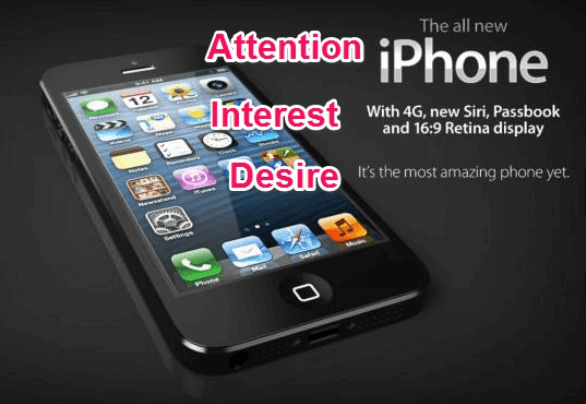
PAS
Most Popular
This is also one of the most well-known formulas among copywriters. Although simple, this formula is highly effective, and has endless applications, including using it to share content on social media and even to evaluate other people’s content.
- Problem: Introduce a problem your reader has encountered.
- Agitate: Agitate the problem using emotional language.
- Solution: Offer a solution to the problem.
As you can see in the following example, the order and placement doesn’t always have to be the same to be effective. The words “You’re Probably Messing Up Invoices” both introduce and agitate the problem.
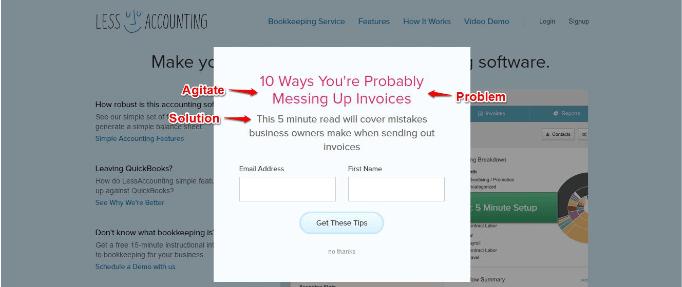
The next few formulas are variations of the AIDA formula.
IDCA
IDCA is a similar variation of AIDA by Earle A. Buckley. It leaves off “Attention”, for times when you already have the reader’s attention, and it adds “Conviction” to reassure and convince the reader to take action. Copy Hackers suggests using testimonials, endorsements, statistics, data points, demos, and guarantees to add Conviction.
- Interest: Create interest by sparking their curiosity.
- Desire: Give them something to desire.
- Conviction: Create the conviction to take action.
- Action: Encourage them to take action.
ACCA
ACCA is another variation of AIDA that highlights clarity and understanding.
- Awareness: Make the reader aware of the problem.
- Comprehension: Add clarity by explaining how it affects the reader and that you have a solution.
- Conviction: Create the conviction to take action.
- Action: Encourage them to take action.
AIDPPC
AIDPPC is another variation of AIDA that Robert Collier considered the right order to write sales letters. The “Desire” element has been divided into “Description”, “Persuasion”, and “Proof”.
- Attention: Grab the reader’s attention.
- Interest: Create interest by sparking their curiosity.
- Description: Describe the problem, the solution, the consequences of not taking action – anything that gives the reader more relevant details.
- Persuasion: Persuade them to take action.
- Proof: Prove that they can trust you to deliver (e.g., with testimonials, endorsements, etc.).
- Close: Close with a call to action.
AAPPA
AAPPA is another variation of AIDA by Victor O. Schwab.
- Attention: Get attention.
- Advantage: Offer an advantage.
- Proof: Prove it.
- Persuasion: Persuade them to take the advantage.
- Action: Encourage them to take action.
PPPP
PPPP is yet another variation by Henry Hoke, Sr.
- Picture: Paint a picture that attracts attention and creates desire for your idea, product, or service.
- Promise: Describe the benefits that you promise to deliver.
- Prove: Prove that they can trust you to deliver on your promise (e.g., with testimonials).
- Push: Encourage them to take action.
The 6+1 Formula
Danny Iny’s 6+1 formula is a great alternative to AIDA, as it highlights the importance of context in effective copywriting.
- Step 1: Context. Establish context by answering the question “Who are you, and why are you talking to me?”
- Step 2: Attention. Grab the audience’s attention.
- Step 3: Desire. Make your audience want something.
- Step 4: The Gap. Now that they know they need to take some kind of action, establish the gap – in other words, explain the consequences of not taking action. Do this by answering the question “What if nothing changed, and what would that mean?”.
- Step 5: Solution. Once you’ve established the gap, quickly offer your solution.
- Step 6: Call to Action. End with a call to action.
Find more about the 6+1 formula at Smashing Magazine.
QUEST
- Qualify: Qualify the reader and prepare them for what they’re about to read.
- Understand: Understand your reader and show them that you understand.
- Educate: Educate them on your solution to their problem.
- Stimulate/Sell: Sell your solution.
- Transition: Transition your reader from prospect to customer.
To learn more about QUEST, check out Want Better Copy? Go On A Quest!
AICPBSAWN
Despite being a bit of a mouthful, the AICPBSAWN formula can be a useful one to have nearby.
- Attention: Grab their attention.
- Interest: Give them a reason why they should be interested.
- Credibility: Give them a reason why they should trust you.
- Prove: Prove that you’re telling the truth.
- Benefits: Tell them how they will benefit.
- Scarcity: Create a sense of scarcity.
- Action: Call them to action.
- Warn: Tell them the consequences of not taking action.
- Now: Create a sense of urgency, so that they take action immediately.
PASTOR
This formula from Emil Kristensen is great for writing landing page copy.
- Problem: Identify the problem.
- Amplify: Amplify the consequences of not solving the problem.
- Story and Solution: Tell a story about someone who solved the problem with your solution.
- Transformation and Testimony: Strengthen your case with real-life testimonials.
- Offer: Describe your offer.
- Response: End with a call to action that tells the customer exactly what to do next.
3 Formulas for More Persuasive Landing Pages
These 3 formulas from Unbounce highlight how important stories are to writing high-converting landing page copy.
- Tell a story no one’s heard before.
- Tell a story that cuts deep with prospects.
- Tell a story with a happy ending.
Read the full post at Unbounce to find more about this formula.
Formula for Blog Posts
According to Michael Hyatt, this formula will help you write better and faster blog posts.
- Compelling title: Grab their attention.
- Lead: Hold their attention.
- Relevant image: Draw your reader’s eye with visuals.
- Personal experience: Let them get to know you, so you can build trust.
- Main body: Make it scannable.
- Discussion question: Encourage commenting and start a conversation.
The following example shows that you can use this formula for other purposes as well. But, instead of a long section on his personal experience, he uses his free screencast to let the audience get to know him and build trust. He doesn’t encourage commenting, but he still encourages taking a specific action – watching the screencast.

FACE
If you’re not sure how long your copy should be, check out this formula from Marketing Words that helps you decide how long your copy should be depending on 4 key factors.
- Familiar: How familiar are your customers with your product or brand? Do you need to build familiarity to evoke trust in them?
- Audience: Who is your target audience?
- Cost: How much does your product or service cost? (A higher cost often means customers will have more questions about it before they spend any money, which means more copy to answer these questions.)
- Education: Do you need to teach your customers anything first?
Find more about this formula by watching the video series at Marketing Words.

Chapter 3: Formulas for Call to Actions
Never forget your call to action (CTA). This chapter covers simple formulas that will make your job easier by telling you exactly what makes up a great call to action.
TPSC
According to BloggingWizard, these are the 4 core areas to consider when creating a call to action button.
- Text: Is your CTA clear, short, and direct? Does it have value and does it create urgency?
- Placement: Is it above the fold? Is it in the most logical place?
- Size: Is it not too small that it’s hard to find, and not too big that it’s distracting?
- Colour: Have you used colour and white space effectively to make it stand out?
Find more about TPSC at BloggingWizard.

Wordstream’s CTA Tips
Most Popular
Even though these are tips on CTAs, they still make a great formula.
- Start with a strong command verb.
- Use words that provoke emotion or enthusiasm.
- Give a reason why they should take the action.
- Make them feel like they’re missing out if they don’t take action.
- Know your devices (customise your CTA based on the device they’re most likely using).
- Don’t be afraid to be creative.
- Use numbers when possible.
Find more about this formula at Wordstream.

Elements of an Offer
The “Elements of an Offer” formula shows you the important elements to include when writing an effective call to action.
- Here’s what you’re gonna get
- Establish the value
- Offer a (conditional) bonus
- Price
- Trivialise Price
- Guarantee
- Risk Reversal
- Scarcity
RAD
Most Popular
- Require: Give visitors the information they require before the CTA.
- Acquire: Make it easy for visitors to acquire your CTA.
- Desire: Make visitors desire what the CTA will give them.
Find more about this formula by Lance Jones at Copy Hackers.
I Want Button
Easy to Use
This formula from Copy Hackers is an easy way to write your CTAs. All you have to do is fill in the blanks, then choose one. The words you use to fill in the blanks will be your CTA.
- I want to __________.
- I want you to __________.
Example: Get a heatmap (from “I want to get a heatmap”). Show me my heatmap (from “I want you to show me my heatmap”).

Get __________
Easy to Use
This is an even easier formula from Copy Hackers. Just start your CTA button with the word “Get”, followed by what customers will get if they click it. Of course, you could also use variations of “get”, such as “claim” or “grab”.


Chapter 4: Formulas for Email Subject Lines
Like headlines, you need to be able to write effective email subject lines that convince the reader to open and read them instead of deleting them. You can use the formulas for writing headlines as well, but here are some formulas specifically for email subject lines.
Try these formulas by Jared Kimball, and find more about them at MarketerLife.
The Report Formula
Easy to Use
- New [Agency/Research Institute] approved [Process/Device] + [Benefit]
Example: New SEO research study reveals the secrets to a successful blog - Innovative [System/Process/Product] + [Benefit]
Example: Innovative blogging technique doubles conversion rates - Introducing [Technique/System/Process] + [Benefit/Mystery]
Example: Introducing new SEO strategies: how to increase your website traffic
The Data Formula
Easy to Use
- [Percentage] + __________
Example: 20% of bloggers never check their blog analytics - ________ is rated as [Best/Worst/Most] + [Noun]
Example: Blogging is rated as the best kind of content marketing - Something cool gets [Percentage Growth/Improvement] over old way
Example: Little-known SEO tip increased my traffic by 120%
The How To Formula
Easy to Use
- Attention-Grabbing Statement + [How To Do Something Better]
Examples: FREE eBook: How to improve your call to actions - How [Outstanding Example/Normal Person] Does Something Cool
Example: How John Smith got 1722 Facebook shares in 5 days - How To [Accomplish/Fix/Solve/Do Something]
Example: How to get more shares on social media - How To [Accomplish/Fix/Solve/Do Something] + Without “X”
Example: How to increase your blog traffic without spending any money
The Inquiry Formula
Easy to Use
- What/When/Where/Who/How + [Question Statement]?
Example: Where do you need the most help with your blog?
Example: Who is the greatest copywriter of all time? - [Brief Statements That End With a Question Mark]?
Example: So you’re a blogger?
The Endorsement Formula
Easy to Use
- “[Insert Quote]” by [Author’s Name]
Example: “Here’s what you need to know about SEO” by John Smith - [Event/Group Name] + “[Insert Quote]”
Example: New announcement on “The Fundamentals of Copywriting Course 2016” - “[Testimonial Quote/Question]”
Example: “I’ve read over 100 books on blogging and none of them compare to this 60-minute video” - [Special Phrase] + [Benefit/Emotional Statement]
Example: Have you heard of “The Endorsement Formula”?
The Loop Formula
Easy to Use
Make sure to close these loops in the actual email, otherwise you’ll frustrate readers.
- FYI + [The Missing Piece]
Example: FYI… There’s more - [Incomplete Statement] + …
Example: The biggest thing to happen to blogging since… - [Something Cool] + For You
Example: Here’s a free gift for you
This/That Formula
Easy to Use
- End the email subject line with “this”
Example: Have you ever done this? - Start the email subject line with “this”
Example: This SEO strategy boosted my blog’s traffic - Blend “that” or “this” intro the email subject line
Example: An easy-as-pie guide that can improve your copywriting - Combine [this] + [that] + […] + [?]
Example: This blog post changed my life…
Note: When you use the word “this” without a noun after it (i.e., when the reader doesn’t know what “this” is), Copy Hackers call it “The Empty Suitcase”.
Wishpond’s Email Subject Line Formulas
Easy to Use
The following formulas from Wishpond are also great for writing email subject lines.
- Hi [Name], this is [Name] from [Business Name]
Example: Hi Alex, this is John from Writtent
Example: Hi Alex, have you read John’s article on the Writtent blog? - What [your industry people] need to [verb]
Example: What bloggers need to know about SEO - Need a better solution for [customer problem]?
Example: Need a better solution for overcoming writer’s block? - One day left, then your chance is gone forever…
Example: Only 2 days left of our massive summer sale. Don’t miss out!
Example: Sale ends soon. Act now, shop now, save! - Exclusive offer, extended for you
Example: As a special thanks for buying our products, here’s a 30% discount
Try the following 2 formulas from Copy Hackers to make your subject lines stand out.
The Punctuator
Easy to Use
As you might’ve guessed from the name, this formula uses punctuation to do the following:
- Visually break up the line of copy
- Visually set your subject line apart from the others
Example: This is it… the solution to all your copywriting problems
Example: Psst… secrets to successful blogs inside
The Shorty
Easy to Use
- Only use one, two, or three words.
Example: Have a moment?
Example: Quick question
Example: Big sale

Chapter 5: Formulas for Drip Email Campaigns
This chapter covers formulas for drip email campaigns to help take the guesswork out of planning what to send new customers.
6-Email Campaign to Nurture Prospect Customers in 14 Days
This formula from BombBomb breaks down a 6-email campaign into the 6 main topics that each email should cover.
- Email 1: Welcome and introduction (include personal contact details)
- Email 2: Key features
- Email 3: How other people are using the same product or service
- Email 4: Examples of ROI for your solution
- Email 5: Testimonials from customers
- Email 6: Frequently asked questions
Wishpond’s 5 Emails to Send Your Prospects
- Email 1: A warm hello
- Email 2: Transparency (be honest about what your business does to build trust between you and prospects)
- Email 3: Send a personal article (let them get to know you)
- Email 4: Case studies (prove that you can do what you say you can)
- Email 5: Free offer/soft-sell (e.g., offer a free trial or consultation)
Find more about this email campaign at Wishpond.
Rob Walling’s 5-Day Drip Email Campaign
Easy to Use
- Day 0: Send this email within 5 minutes of sign-up. Welcome them, provide an overview, and end with a call to action.
- Day 1: 24 hours later. Send actionable information.
- Day 2: 24 hours later. Tell a story.
- Day 3: 24 hours later. Send more actionable tips.
- Day 4: 24 hours later. Send a case study.
Find more about this email campaign at Copy Hackers.

Chapter 6: Formulas for Ads
This chapter includes formulas for search ads, general ads, and Facebook ads.
AIU
This simple formula is great for search ads, and can also be used for direct-response envelopes.
- Attention
- Interest
- Urgency
PPC Ad Copy Formula
Most Popular
Another great search ad formula is this one from Blast Analytics and Marketing.
- Headline: Attract the reader’s attention.
- 1st Description: Spark their interest.
- 2nd Description: Call to action.

Wordstream’s Ad Copy Formulas
Easy to Use
When writing copy for search ads, identify your unique selling point in the first description line. Here are some formulas to help you do this from Wordstream.
- Unforgettable and Affordable __________.
- Your Search for __________ Ends Here.
- Get __________ For Only $___.
- Looking For Help With _________?

Convert searchers with your second description line by using a call to action. Try these ones from Wordstream.
- Start Searching Now!
- Order Our Expert Guide Today!
- Start ___ Days of Unlimited __________!
- Register Now and Get __________ Free!

Check out Wordstream for plenty more of these helpful formulas.
4-Step Formula for Facebook Ads
This simple formula from SEMrush will have you writing great copy for Facebook Ads in no time.
- Have a clear objective.
- Offer benefits.
- Be persuasive.
- Know Facebook’s rules.
This formula is also great for general Facebook posts, such as in the following example.

Simple Formula for Facebook Ads
According to Temitayo Is Marketing, this short and simple formula will help make your Facebook ads stand out.
- Be loud.
- Be relevant.
- Be engaging.

Chapter 7: Formulas for Social Media
If you’re struggling to gain the shares, likes, and comments that you want for your blog posts, products, or services, try using formulas to write your social media posts.
Copy Hackers’ Facebook Post Formulas
Easy to Use
These Facebook post formulas from Copy Hackers are a great way to get you started. Check out their site for more of them.
- Fill in the blank: “[Unfinished statement]” __________.
Example: Fill in the blank: “The best content writing tip is __________. - “Like” if you [something your readers will probably like]
Example: “Like” if you read more online than you do in print. - Remember when [something nostalgic]?
Example: Remember when we didn’t have to worry about SEO?
HubSpot’s Twitter Formulas
Easy to Use
These formulas for writing the best Tweets from HubSpot are also worth checking out. Here are some of them, but check out their site for more.
The basic “share an article” Tweet:
- [Article Title]: [Link to article] #hashtag by @TwitterHandle
Example: 29+ Actionable Writing Tips: writtent.com/blog/content-writing-tips/ #writingtips by @Writtent
The “did you know?” Tweet:
- Did you know that [Stat/Fact]? [Link to source] #hashtag
Example: Did you know the standard blog post title length is 40 characters? blog.hubspot.com #blogging
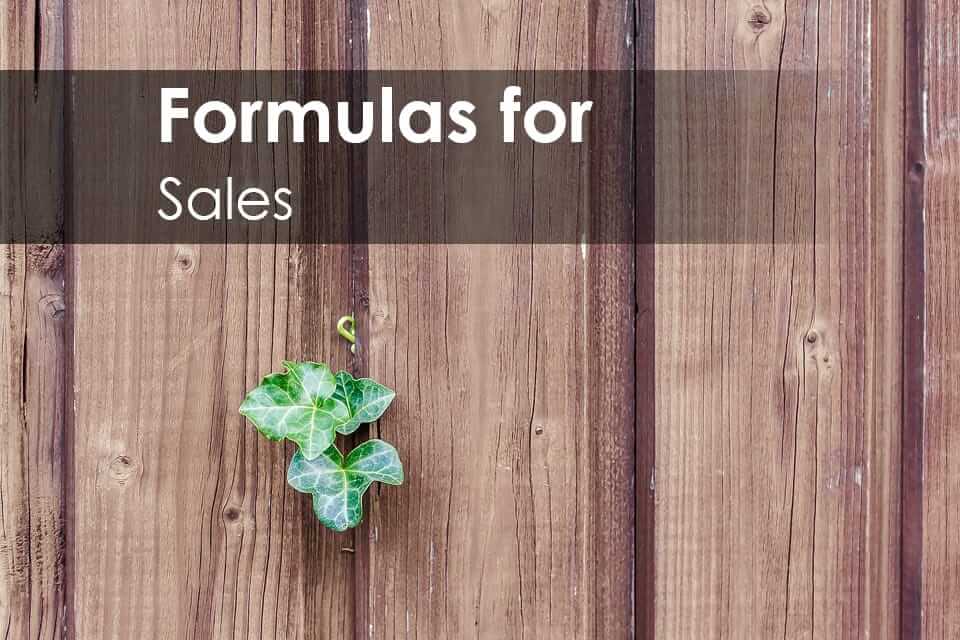
Chapter 8: Formulas for Sales
This chapter covers the best copywriting formulas to use for sales pages; however, as noted at the start of this guide, you can use these formulas in other areas as well.
Consider using these formulas if you have to sell something – whether you’re trying to sell a product, service, or idea.
1-2-3-4
Most Popular
- What I’ve got for you: What is it that you’re selling?
- What it’s going to do for you: How will it benefit the reader?
- Who I am: Why should the reader trust you?
- What you need to do next: End with a call to action.
To learn more about the 1-2-3-4 formula, check out Copyblogger.
SLAP
Never forget your reader. Use this formula to check that your copy makes your readers stop, look, act, and purchase.
- Stop: Grab their attention.
- Look: Keep them reading. Hold their attention.
- Act: Call them to action.
- Purchase: Convince them to buy.
Star Story Solution (SSS)
Most Popular
Use this formula to tell a compelling story that will sell your product, service, or idea.
- Star: Who is the main character? (e.g., you, your customer, a celebrity, etc.)
- Story: Make it relatable. Appeal to their emotions.
- Solution: Explain how taking action will solve the main character’s problem.
Star-Chain-Hook
Most Popular
This formula by Frank Dignan is great for ads and sales.
- Star: Grab the reader’s attention with your “star” (e.g., your product or idea)
- Chain: Offer a chain of benefits and reasons to make the reader want the “star”.
- Hook: End with a call to action to hook them in, turning prospects into customers.
String of Pearls
Most Popular
This one doesn’t come with specific steps, but Buffer explains it perfectly: “String together a series of persuasive stories”. The main purpose is to make your copy as persuasive as possible.
Here are some ways to use this formula:
- Write a list post
- String together convincing testimonials
- String together benefits
The Five-Point Copywriting Formula
Use this formula by Jack Lacy as a guide for writing sales letters.
- What will you do for me if I listen to your story?
- How are you going to do this?
- Who is responsible for the promises you make?
- Who have you done this for?
- What will it cost me?
Bob Stone’s 7-Step Formula for Sales Pages
- Begin with your strongest benefit.
- Expand on this benefit.
- Explain exactly what the prospect will get.
- Back up your statements with proof.
- Tell them what they’ll lose if they don’t act.
- Sum up the most important benefits.
- Present your call to action.
To find more about this formula, check out HubSpot.
The Nine-Point Formula
This formula by Frank Egner is intended for detailed sales letters.
- Start with a headline (or first paragraph) to get attention and arouse desire.
- Follow with an inspirational lead.
- Give a clear definition of the product.
- Tell a success story about the product.
- Include testimonials and endorsements.
- List special features.
- Present a statement of value to the prospect.
- Use specific and urgent action copy.
- End with a postscript.
Bob Serling’s Power Copywriting Formula
This formula by Bob Serling is an incredibly detailed, 36-step formula.
It starts with 4 prerequisites.
- Prerequisite 1: You must have a quality product
- Prerequisite 2: Creating and using the ideal customer profile
- Prerequisite 3: Credibility produces maximum profits
- Prerequisite 4: The offer is everything
Then continues with the following 32 steps:
- Conduct exhaustive research before writing
- Rest and percolate (your ideas)
- Create a comprehensive list of features, facts, and figures
- List all benefits
- Create an irresistible offer
- Create an extraordinary guarantee
- Write a powerful headline
- Use colour to highlight key points
- Keep the graphics to a minimum
- Write an opening paragraph that immediately delivers on what you promised in the headline
- Eliminate all objections before they can be made (i.e., with “Pre-Emptive Strike Credibility”)
- Write compelling sub-headings that guide the reader
- Use words that provoke emotion to make your reader aware of their pain
- Eliminate their pain
- Establish your credibility
- Add to your credibility with an “insider’s” benefit
- Prove to them that you can deliver on your promises
- Break up your text so that it is easier to read
- Use bullet points to list benefits
- Briefly sum up the key benefits
- List product features
- Go that extra step for your customers
- State the price
- Call to action
- Include a piggy-back offer to increase profits
- “Shift the Risk”
- Sum up major benefits
- Use a PS
- Make it easy to order
- Avoid links that aren’t relevant to the sale
- Rest and percolate
- Check and rewrite to make more effective
Brian Carter’s Dramatic Copywriting Formulas
Easy to Use
These formulas by Brian Carter are great for promoting products, services, and brands to increase sales.
- “I’m so proud to be an __________.”
Example: I’m so proud to be a content marketer, because I help businesses reach their customers with fresh, interesting content. - “If you’re __________ we’ll take care of you.”
Example: If you’re not driving enough traffic to your blog, we’ll take care of you. - “To __________… It gives me chills just thinking about it.”
Example: To triple your conversions just by updating your SEO strategies… it gives me chills just thinking about it. - If you want to __________ you have to __________.”
Example: If you want to write effective copy for Facebook ads, you have to know the rules.
Find more of these formulas at the Brian Carter Group.
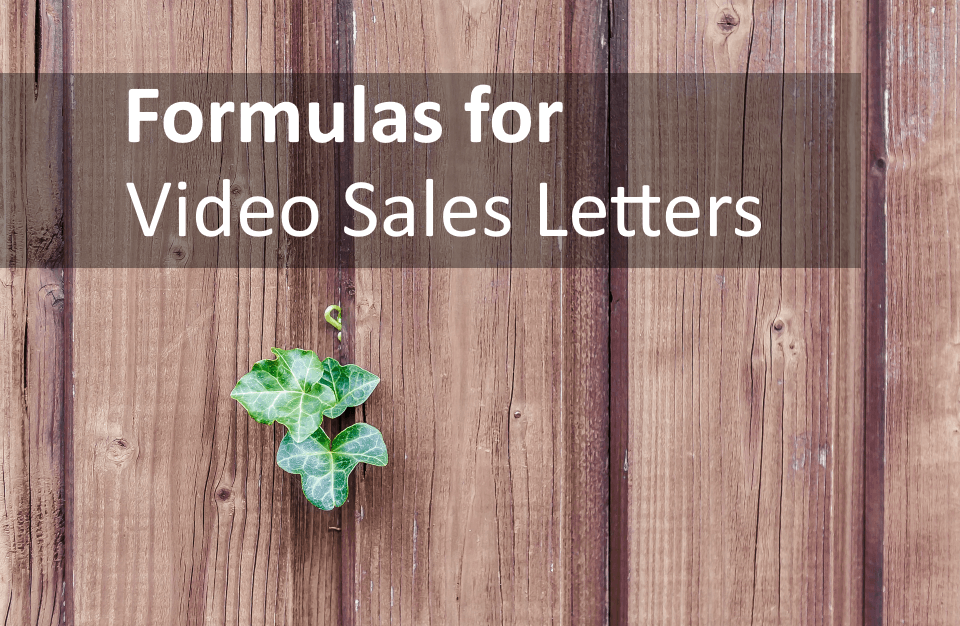
Chapter 9: Formulas for Video Sales Letters
This chapter covers the formulas for creating great video sales letters, starting with this common one from Copy Ranger.
Common Video Sales Letter Template
- Start with an attention-grabbing greeting
- Identify a problem and promise to solve it
- Create a sense of scarcity (to convince them that they need your solution now)
- Aggravate the problem
- Offer the solution
- Describe the features and benefits
- 1st call to action (desire-based CTA)
- Establish your credibility with proof, results, examples, and testimonials
- Give the Guarantee
- 2nd call to action (logic-based and desire-based CTA)
- Create a sense of scarcity and urgency
- 3rd call to action (fear-based and desire-based CTA)
Jim Edwards’ Video Sales Letter Script Formula
Easy to Use
This is another great VSL formula, from The Jim Edwards Method.
- Open with a shocking statement
- State the problem and why it matters
- Agitate the problem
- Agitate the problem even more
- Introduce your solution
- Establish your credibility
- Give them proof to convince them further
- List key features and benefits
- Explain why they should act now (create a sense of urgency and scarcity)
- Call to action and reinforce the benefits

Chapter 10: Formulas for Value Propositions
When written well, value propositions can help boost conversions and sales, so try the formulas in this chapter.
Wishpond’s 7 Value Proposition Formulas
According to Wishpond, their 7 value proposition formulas can boost conversion on ads and landing pages.
- Free!
- Offer success
- Enter to win
- State the ROI
- Peer or social endorsement
- The If/Then Promise
- The comparison
Find more about these formulas at Wishpond.
Copy Hackers’ Value Proposition Formulas
Easy to Use
The following are some great value proposition formulas from Copy Hackers. Check out their site for more.
- The [adjective] way for __________ to __________, [benefit/outcome].
Example: The easy-as-pie way for writers to turn passive readers into active readers – for better call to actions. - We do __________, but the difference is [primary differentiator].
Example: We help bloggers increase their traffic, but the difference is that we only provide the most practical and actionable tips because we know how frustrating it can be when you’re forced to go looking for more information. - [Superlative] [category] [qualifiers]
Example: The most comprehensive content writing eBook for bloggers.
FAB
Kevan Lee from Buffer points out that what’s great about this formula is its focus on benefits rather than features.
- Features: Describe the features (e.g., the features of your product)
- Advantages: Describe the advantages (what does it help you do?)
- Benefits: Describe the benefits (what do they get out of it?)
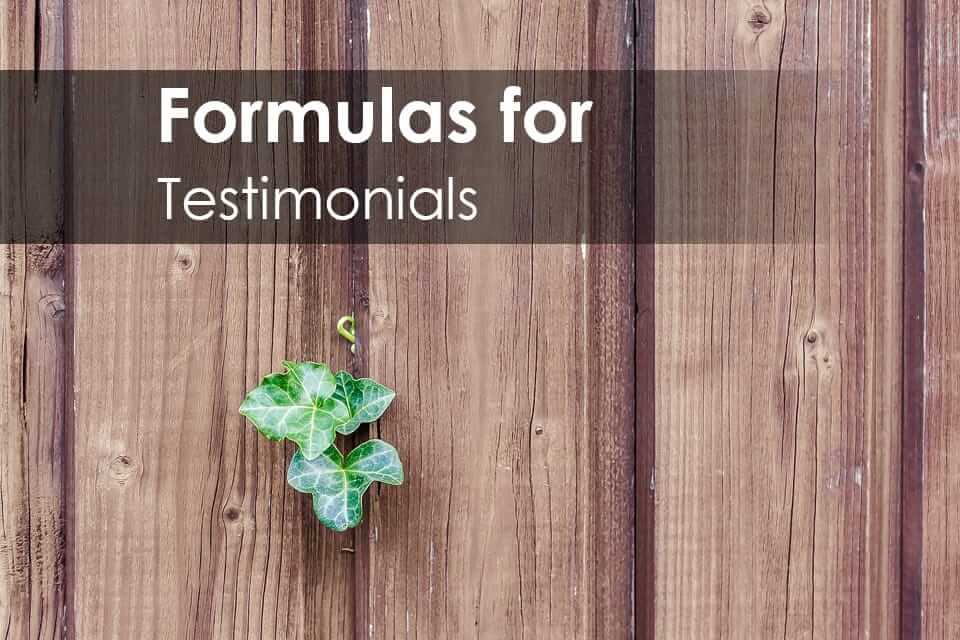
Chapter 11: Formulas for Testimonials
If you’ve read the previous chapters, you’ll notice that many of the formulas use testimonials to convince readers of something. If you’re using one of those formulas that require a testimonial, try these testimonial formulas.
Before and After
Most Popular
Tell a convincing story by using these 3 core elements from Psychotactics.
- Before: How the customer felt before buying your product (hesitation)
- After: What they discovered after they bought your product (discovery)
- The experience: How they felt afterwards (emotional response)
TEASE
This formula from Business Exchange has more elements and takes a different approach.
- Tactful: Always be tactful.
- Emphasise: Highlight the strengths.
- Authentic: Show that you’re authentic.
- Short: Keep it short. Only write about the most important aspects.
- Engaging: Use personal examples to make it more engaging.
SSSS Vs. LLLL
Easy to Use
According to AWAI, testimonials should be the following:
- Specific
- Short
- Sizzling
- Signed
And they should avoid the following:
- Lacking a point
- Long
- Lame
- Lazily-written
Easy-to-Use Testimonial Template
Easy to Use
Filling out this template from EnchantingMarketing is a great way to find the main points to include in your testimonial.
- I approached [business name] because __________.
- [Business name] helped me by __________.
- The result was __________.
- One thing I liked was their __________.
- I found the experience __________.
- I would recommend [business name] to people who need __________.
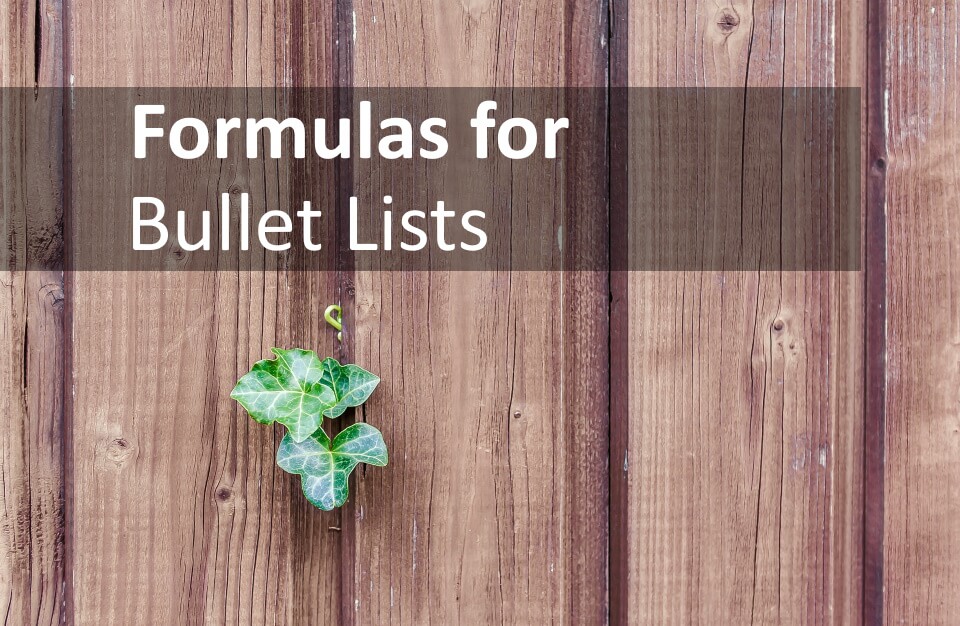
Chapter 12: Formulas for Bullet Lists
This chapter covers formulas for writing bullet lists, which you may be surprised to see included in this guide. Although they seem easy enough, why not make it even easier with these formulas?
4 Essentials of Writing Bullet Points
Although this one from Copywriting In Action is not called a formula, it’s still great to use as one. Make sure that your bullet lists follow these essentials.
- Use them to call the reader’s attention to the benefits
- Make them symmetrical
- Simplify them if too cluttered and overly complex
- Make them parallel (e.g., if one starts with a verb, start the next one with a verb)
Bullet Point Order
Easy to Use
Use this simple BGNGo formula from Copy Hackers to put your bullet points in the most effective order. The first and last bullets should be the most compelling points.
- Best: Start with your strongest point.
- Good: Follow with another good point.
- Necessary: Add the other points that aren’t as great as the first one but that you still need.
- Good with Outcome: End with a strong point and outcome.
7 Deadly Fascinations
This creative formula from Copy Hackers is based on the 7 deadly sins, and is a great way to make your bullet points stand out. Follow the order in the previous formula by starting and ending with your strongest points, and moving your weaker points into the middle of the list.
- Lust: Make them desire what you have (e.g., your solution).
- Sloth: Create a sense of simplicity so that prospects know how easy or quick your solution is.
- Envy: Make them envy those who have your solution.
- Pride: Show how amazing your solution is.
- Wrath: Aggravate the problem.
- Gluttony: Explain how they can have it all.
- Greed: Explain how they can get the solution and use power words to help trigger their greed.
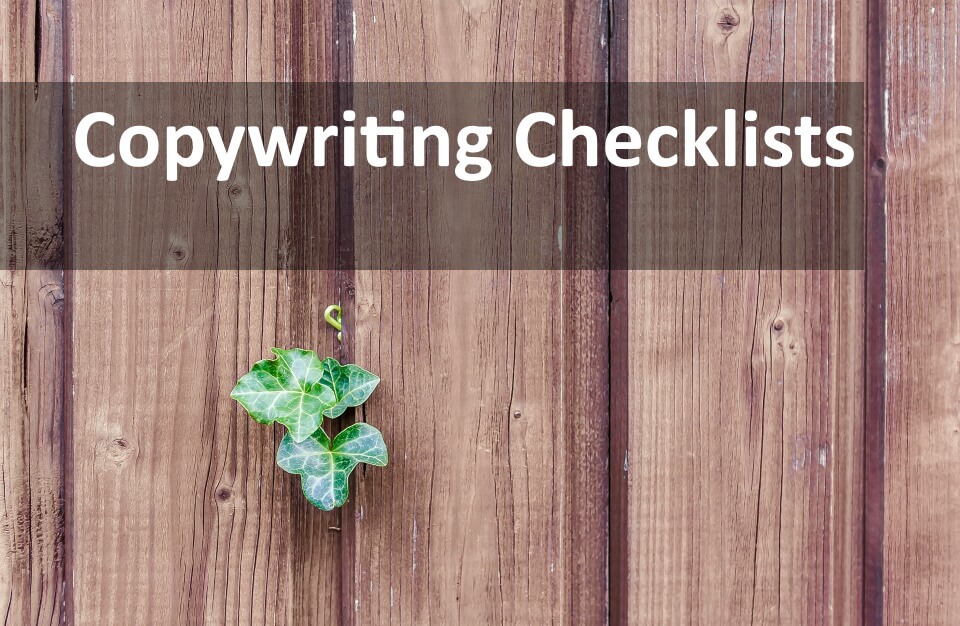
Chapter 13: Copywriting Checklists
This chapter covers copywriting checklists that you can either use as formulas or as reminders when you go back through your copy before publishing it.
The ABC Checklist for Copywriting
Most Popular
Although the ABC checklist is a checklist, not a formula, it provides a long list that sums up the key points to address in your copy.
- Attain Attention
- Bang out Benefits
- Create Verbal Pictures
- Describe Success Incidents
- Endorse With Testimonials
- Feature Special Details
- Gild With Values
- Honor Claims With Guarantees
- Inject Action in Reader
- Jell With Postscript
A FOREST
Most Popular
Use this helpful mnemonic as a formula, or just keep it nearby to remind you of the key elements of sales copy.
- Alliteration: Use alliteration to make your words catchy and memorable.
- Facts: State facts and back-up your claims with proof.
- Opinions: Prospects like to know what other customers think.
- Repetition: Repeat important points to remind the reader.
- Examples: Give relevant and relatable examples.
- Statistics: Use statistics to be more specific.
- Threes: Repeat three times to make sure readers remember.
Have any copywriting formulas of your own? We’d love to hear about them in the comments below!

Comments (0)